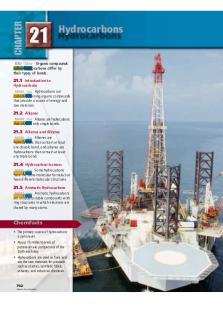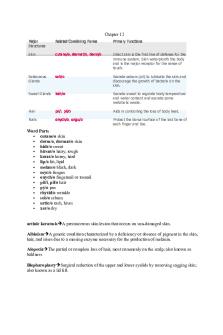CHAPTER 12: HYDROCARBONS 1 PDF

| Title | CHAPTER 12: HYDROCARBONS 1 |
|---|---|
| Author | Nurul Najwa |
| Pages | 2 |
| File Size | 50.2 KB |
| File Type | |
| Total Downloads | 34 |
| Total Views | 79 |
Summary
CHAPTER 12: HYDROCARBONS 1. a) Suggest the product formed when cyclopentane reacts with chlorine gas in the presence of light. b) Name the type of the reaction in (a) c) Write mechanism for the chlorination of cyclopentane. [5 marks] 2. Compound A is 4-chloro-2-pentene. i. Draw and label the cis-tra...
Description
CHAPTER 12: HYDROCARBONS 1.
a) b) c)
2.
Suggest the product formed when cyclopentane reacts with chlorine gas in the presence of light. Name the type of the reaction in (a) Write mechanism for the chlorination of cyclopentane. [5 marks]
Compound A is 4-chloro-2-pentene. i. Draw and label the cis-trans isomers of A. ii. Can A exist as a pair of enantiomers? Explain your answer. [4 marks]
3.
4.
a)
State the reagents and write the equation for the formation of 2,3-dibromobutane from 2-bromobutane. [3 marks]
b)
Dehydration of 3-methyl-2-butanol with concentrated sulphuric acid yields a mixture of three alkenes. Draw all the structure of alkenes and suggest the major product. Propose the mechanism of its formation. [6 marks]
a)
C5H12 is an aliphatic compound which has several structural isomers. i. Draw structural formulae for all isomers of C5H12. ii. Arrange the above isomers in the order of increasing boiling point. Explain. iii. Choose the isomer which gives only one product in the bromination reaction. [6 marks]
b)
Give IUPAC name for 2,5-diethylcyclopentene. Draw the structure of the major product formed when this compound is reacted with H2SO4/H2O. [2 marks]
5.
2-bromobutane reacts with alcoholic sodium hydroxide solution to give major product, B and minor product, C. B is subsequently reacted with HBr to form D. i. Name the rule used for the formation of B and C. ii. Draw the structures of B, C and D. iii. Give the IUPAC name for B and D. [6 marks]
6.
Arrange the following compounds in order of increasing boiling point. Explain. 2-methylpentane
hexane 2,3-dimethylbutane 2,2-dimethylpentane [5 marks]
7.
Dehydration of 1-butanol gives alkenes, X and Y. Reaction of X and Y with bromine in carbon tetrachloride produces dihalides AA and BB respectively. Give structures X, Y, AA and BB. [4 marks]
1
CHAPTER 12: HYDROCARBONS 8.
Compound K, C5H10 reacts with bromine in the presence of ultraviolet light to give only L, C5H9Br. Compound K does not react with acidified solution of potassium manganate(VII). Upon treatment with potassium t-butoxide, L gives only one product, M, C5H8. M decolourises bromine water and ozonolysis of M gives N, C5H8O2. Deduce the structures of compounds K through N. Write an equation for the reaction of M with bromine water. [8 marks]
9.
Compound A has a molecular formula of C7H14. A reacts with bromine in dichloromethane to form 1,2-dibromo-3,4-dimethylpentane. Treatment of A with HCl gives B and C. i. ii.
iii. iv.
10. a)
b)
Draw the structural formulae of A,B and C. [3 marks] Draw the structures of the carbocation intermediates in the formation of B and C. Indicate the more stable carbocation and give your reason. [4 marks] Name the type of reaction for the formation of B and C. [1 mark] Predict whether A can exist as a stereoisomer. Explain your answer. [2 marks] Compound D,C5H10 is a cyclic compound that can exist in many isomeric forms. i. Draw the structural formulae of all possible cyclic isomers of D. ii. Show a pair of diastereomers. There is an isomer of D which can react with bromine in the presence of ultraviolet light to give only one monobrominated product,E i. Which isomer can form E? Draw the structure of E. ii. Name the type of reaction iii. What is the function of ultraviolet light in the reaction? [10 marks]
11. The molecular formula of the five-membered cyclic compounds is C7H14.
i. ii.
Draw all geometrical isomers of the above five-membered ring compounds. Which isomers can form enantiomers? [5 marks]
2...
Similar Free PDFs

CHAPTER 12: HYDROCARBONS 1
- 2 Pages

Hydrocarbons
- 10 Pages

Chapter 21 Hydrocarbons Module
- 42 Pages

THE SATURATED HYDROCARBONS
- 9 Pages

dynamics chapter 12 part 1
- 8 Pages

Chapter 12
- 14 Pages

Chapter 12
- 20 Pages

Chapter 12
- 18 Pages

Chapter 12
- 2 Pages

Chapter 12
- 16 Pages

Chapter 12
- 10 Pages

Chapter 12
- 46 Pages
Popular Institutions
- Tinajero National High School - Annex
- Politeknik Caltex Riau
- Yokohama City University
- SGT University
- University of Al-Qadisiyah
- Divine Word College of Vigan
- Techniek College Rotterdam
- Universidade de Santiago
- Universiti Teknologi MARA Cawangan Johor Kampus Pasir Gudang
- Poltekkes Kemenkes Yogyakarta
- Baguio City National High School
- Colegio san marcos
- preparatoria uno
- Centro de Bachillerato Tecnológico Industrial y de Servicios No. 107
- Dalian Maritime University
- Quang Trung Secondary School
- Colegio Tecnológico en Informática
- Corporación Regional de Educación Superior
- Grupo CEDVA
- Dar Al Uloom University
- Centro de Estudios Preuniversitarios de la Universidad Nacional de Ingeniería
- 上智大学
- Aakash International School, Nuna Majara
- San Felipe Neri Catholic School
- Kang Chiao International School - New Taipei City
- Misamis Occidental National High School
- Institución Educativa Escuela Normal Juan Ladrilleros
- Kolehiyo ng Pantukan
- Batanes State College
- Instituto Continental
- Sekolah Menengah Kejuruan Kesehatan Kaltara (Tarakan)
- Colegio de La Inmaculada Concepcion - Cebu



